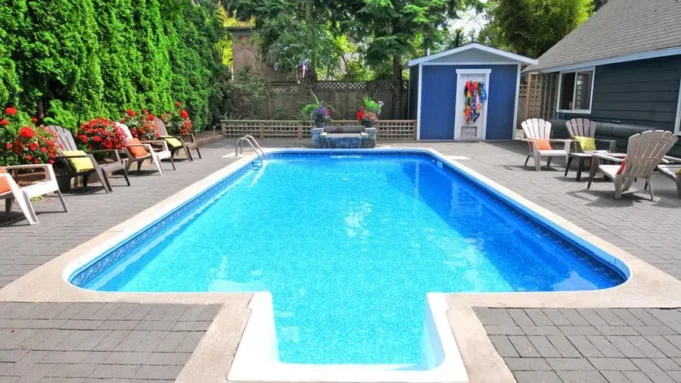Nothing screams luxury and relaxation quite like an inground pool in your backyard. The glimmering water beckons with the promise of tranquil afternoons and family fun, making it an appealing feature for homeowners seeking to elevate their outdoor living space. However, along with the glamor and enjoyment, an inground pool brings a multitude of financial considerations. This blog post will delve into the true cost of owning an inground pool, moving beyond the initial price tag to encompass the myriad of expenses associated with installation, equipment, maintenance, repairs, insurance, water usage, and more.
Installation Expenses
Installing an inground pool is no small feat, with the process involving multiple steps, each with its own set of costs. Design and engineering can run between $500 to $3000, depending on the complexity of the project. Moreover, excavation and construction expenses are another major factor, usually ranging from $35,000 to $65,000 for a concrete pool. Further, additional costs come in the form of landscaping and fencing – required by law in most jurisdictions. Landscaping changes can cost from $1,500 to $5,500, while fencing installation can be $2,500 or more.
Equipment and Accessories

After installation, the pool requires a range of essential equipment such as pumps, filters, and heaters. These elements ensure the pool stays clean, safe, and comfortable for swimming. This equipment can run between $1,000 and $3,000 initially, with replacement costs to be considered in the long-term. Accessories, such as covers, cleaning tools, and lighting, also add to the total cost, running anywhere from $100 to over $2,000, depending on the quality and type of accessories selected.
Regular Maintenance and Cleaning
Keeping your pool crystal clear and safe to swim in requires regular maintenance and cleaning. Chemicals and water testing kits are a recurrent cost, with an annual price tag of about $500 to $800. Hiring professional maintenance, as a primary inground pool cost, services is another consideration, with prices ranging from $80 to $120 per month. Energy costs for running the pool’s pumps and heaters can also add a significant amount to your utility bill each month.
Repairs and Upgrades
Pool repairs for issues such as leaks, cracks, or equipment failures can range from a few hundred to several thousand dollars. Regular inspections and proactive maintenance can help prevent such issues, but unexpected repair costs should always be factored into a pool ownership budget. Upgrading its features and technology can also incur additional costs but can enhance the pool’s value and user experience.
Insurance and Liability
When you decide to add an inground pool to your property, it’s crucial to consider the implications this will have on your homeowner’s insurance premiums. The presence of a pool increases liability risks, often leading to a spike in insurance costs. These expenses can oscillate widely depending on several variables including your geographic location, the insurance provider, and the specific features of your pool like depth, size, and the presence of a diving board.
The frequency of use and accessibility to the general public can also impact premiums. Furthermore, if any accidents occur in or around the pool, liability issues come into play. Depending on the severity of the accident, legal fees and potential payouts can lead to hefty financial burdens. It’s crucial to understand these possibilities and have a comprehensive insurance plan to mitigate such risks.
Water Usage and Conservation

Having a pool significantly heightens a household’s water usage, inevitably leading to an augmentation in utility costs. These expenses can fluctuate depending on numerous factors, such as the geographic location, local water rates, size, and evaporation rate. Regardless of these factors, you should be prepared for a noticeable increase in your water bill post-pool installation. To combat these rising costs, you can consider implementing water conservation measures.
One such measure is investing in a quality pool cover, which can drastically reduce water evaporation. Although there is an initial cost to this investment, the long-term savings can be substantial. Additionally, a cover can also help maintain the pool’s temperature, leading to potential savings on heating costs.
Seasonal Expenses
The costs associated with owning an inground pool are not restricted to installation, equipment, and maintenance alone. Seasonal expenses, such as opening and closing it at the start and end of the swimming season, also add to the financial commitment. Professionals typically charge between $150 to $300 for each opening and closing.
This involves cleaning, water balancing, and reassembling or disassembling the pool equipment. In addition to these costs, winterizing the pool, a necessary process in colder climates, adds another $150 to $300 to your annual costs. This process ensures that the pool and its equipment are protected from potential freeze damage during winter months.
Safety Measures and Compliance
To ensure a safe swimming environment, several safety measures such as alarms, barriers, and lifeguard equipment are required. These elements not only add to the cost of pool ownership, but they also highlight the responsibility owners have to prevent accidents. Alarms and barriers can help prevent unauthorized access or accidental falls into the pool, especially crucial for households with children or pets.
Besides, compliance with local regulations and building codes may necessitate additional expenses. For example, many municipalities require fences of a certain height around pools, along with self-closing and self-latching gates.
Property Value Implications

The impact of a pool on property value is a double-edged sword. While it might attract certain buyers and increase the home’s aesthetic appeal, it can deter others due to maintenance concerns. Consider your local real estate market and consult with professionals before installing a pool with the hope of adding value.
Lifestyle Considerations
The time commitment for pool maintenance and upkeep is a significant non-monetary cost to consider. Balancing its water, cleaning, and general maintenance can become a time-consuming weekly task. Seasonal limitations and associated costs, like heating and maintenance during off-seasons, should also be factored into your decision-making process.
Conclusion
Owning an inground pool can be a rewarding and enjoyable experience, but it’s essential to consider the financial implications fully. This analysis only scratches the surface of the true cost of owning one. It’s not just about the initial installation expense; ongoing maintenance, equipment, repairs, and additional costs contribute to the total. The decision to install a pool should be made after careful consideration and comprehensive budgeting, ensuring that it brings joy and relaxation, not financial stress.















